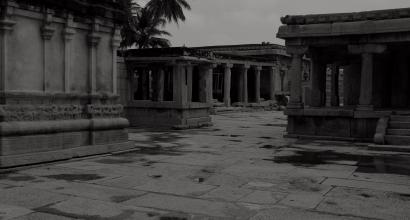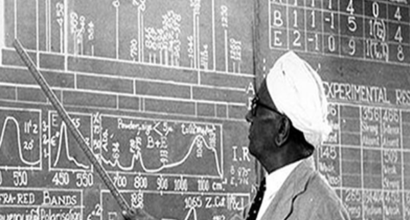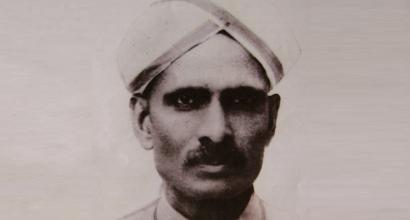‘English Poems'
A few poems from Srikantaiah’s “English Gītagaḻu” (meaning English Poems) were published at regular intervals in the monthly “Karnataka Granthamāle”. N.S. Subbarao liked the poems and had spoken to us about them. He had compiled the poems and had gotten it neatly bound with the title embossed in gilt. He had gotten the title written in beautiful golden letters. I felt a great sense of pride looking at it.
I met the editor of Karnataka Granthamāle Mr. Bapu Subbarao and requested him to give me a copy of the poem collection. Mr. Bapu Subbarao was my teacher in during my High School years at the Maharaja College. However,his affection for me did not stem from the fact that I was his student. He was genuinely soft-hearted and friendly. He was very kind to me and granted me the entire volumes of “Vidyādāynī” newspaper and of “Karnataka Granthamāle”. I got them bound and kept them with me. However, at that time, I had no idea of the kind of far reaching effects B.M. Srikantaiah’s “English Gītagaḻu” would have. I had initially felt that it was merely a good experiment.
The credit for publishing “English Gītagaḻu”, in its entirety, goes to Bangalore Karnataka Sangha. It was mainly the work of two persons, viz., T.S. Venkannaiah and A.R Krishna Shastry, both the students of Srikantaiah. As they were scholars of literature, they were excited about the sublime value of “English Gītagaḻu” from a literary point of view and had obtained their teacher’s permission to publish them. After the book was published, a party was thrown in the Central College. I had attended the party. As far as my memory goes, the event was held on the terrace of the new building that was constructed in the premises of the District Office opposite the Central College. The snacks arranged on that day seemed to exceed Krishna Shastry’s class. There was everything, - fruits, coffee, lemonade. As per the request of the audience, Srikantaiah read out a few poems.
ಬೇಟಕಾರ ಬಂದ ಮಾದ
ಹಹ್ಹ! ಏನು ಬೇಟವೋ!
(ಬೇಟ - Beta means romance). When this was read, I narrowed my eyes and looked questioningly at Srikantaiah. He looked at me, laughed and said, “There is no personal experience here.” I retorted, “Then why are you feeling the strain?” Laughter was our language at that time.
I whispered my answer to him -
ಊಟಗಾರ ಗುಂಡ ಬಂದ
ಆಹಾ ಏನು ಊಟವೋ ।
In this manner, I added 3-4 lines more. He got a little angry. “If you start making fun like this, what will you leave? What is safe?”
“Not like that, sir. I was only trying to show the richness (ಹುಲುಸು) rhyming words in Kannada language.”
He too then laughed.
“Richness” (ಹುಲುಸು) was a word that used to come to Srikantaiah over and over again.
On the cover page of “English Gītagaḻu”, he had quoted from the Bible and the statement read: “It appears that the crops are required. However, harvesters are scarce”. The gentleman ‘Koravanji’ made fun of the said statement like this: “The neck is long. Those who can slit it are scarce”.
This ridicule of mine, especially infuriated Venkannaiah. His admiration for his guru was limitless. It was not impossible for me to convince him.
In the introduction to English Gītagaḻu of B.M. Srikantaiah, it was written as follows:
ಹೀಗೆ ನನಗೆ ಹಬ್ಬವಾಗಿ,
ಇನಿಯರಿಬ್ಬರನ್ನು ತೂಗಿ,
ಇವಳ ಸೊಬಗನವಳು ತೊಟ್ಟು ನೋಡಬಯಸಿದೆ;
ಅವಳ ತೊಡಿಗೆ ಇವಳಿಗಿಟ್ಟು ಹಾಡಬಯಸಿದೆ.
Regarding this, I said, “Sir, this is very nice one. Good arrangement of words. The taste of our people has to be corrected”. He asked me with an angry tone, “Are you ridiculing me again?” I said, “What? No! Since the topic was good, I asked you with the intention of knowing more. Did she agree to the way you draped it?” Srikantaiah said, “What can she do other than giving her consent for it?”
I said, “How can you say that sir? Would you be able to see if she knots her face and hisses at you? Our friend Sri. Abakada Rao made his wife wear high heeled shoes and brought her to the Glass House in Lalbagh in Dog Cart and asked her to walk there. She replied, ‘I belong to the old generation and these things don't go well by me. You may marry a new one for such mischief.’ About three or four of us were sitting there. We could overhear that conversation in bits and pieces. Later, I called Abakada Rao and asked, ‘You stupid fellow! Why are you upto such funny business?’ He too then laughed. So, if women get angry and unresponsive, what would be your solution, please explain.”
The conversation died in laughter.
Humorous Incidents
One of the several humorous incidents that used to transpire between B.M. Srikantaiah and me was regarding the name of his sub-caste. He was a Babbūrkammi.
I would say, the word “Babbūr” is a derivative of the word “Barbara”, meaning barbaric; Barbarians, yavana, mlechchas – all of them were born through the rump of the divine cow Kāmadhenu when she shook her body in retaliation to the dominance of Viśvāmitra. At that time, “barabara” sound came out of its bum. That is why they were called “barbarians”. The word “brahmin” also originated similarly. Nandikeśvara farted and it sounded like “barrr” and when Bhṛṅgi farted, it sounded like “maṇa maṇa” and that is how the word “brāhmaṇa” originated. The origin of the word “babbūrkammi” also originated.
“Barbara” means wind and that is because when it blows, it sounds like “barrr”. So, the basil pulse is named symbolically after the word that originated from wind. And they say it is hyacinth bean or field bean (ಅವರೆ ಕಾಳು). It means blowing fiercely. The pulse hyacinth bean or field bean is a favourite food of the planet Mars i.e., the deity Aṅgāraka.
“ಬರ್ಬರಾಸ್ಸರ್ವಜಂತೂನಾo ಬಲಪುಷ್ಟಿವಿವರ್ಧನಮ್।।”
And the lord Aṅgāraka is the favourite deity of barbers. And due to this reason, the word “barber” was coined in English.
This is the history of the Babbūrkammis. This is how I would argue in a ridiculing manner. Srikantaiah would laugh and remark, “What sir – you reduced us to this! Yours is great philology!”
One day the senate was in session. Vrajendranath Seel was the Vice Chancellor and the president of the assembly. Srikantaiah, who was the Registrar then, was sat next to him in a dignified manner. One of the spectators was asking very biting questions regarding a few great people. I felt that the tone of those questions was not justified. I wrote a few lines on a piece of paper and secured it in an envelope and sent it to Srikantaiah through the servant. He opened the envelope. His face bloomed. He looked towards me and signalled at me. I stood up and went to the room at the back. He also came there. He showed me my chit and said laughingly, “you have insisted that this should be sung in Raga Todi – I do not know Todi. Please demonstrate”. I had written like this:
ಗೋಳಂ ಪೊಯ್ಕೊಳ್ಳುವನೀ ।
____ಳೆಯಮಗನೇತಕಿಂತು ಸುಜನರನಕಟಾ ।।
ಕೋಳಿಯ ಕೂಗೇಂ ಗ್ರಂಥಂ
ಬೋಳಿಯ ತಲೆಯೊಂದು ರಾತ್ರಿಯೊಳ್ ತುರುಬಹುದೇಂ ।।
The laughter that started after listening to this was heard by a few members in the meeting. They also came and joined us in our laughter.
To be continued....
This is the twenty-second essay in D V Gundappa’s magnum-opus Jnapakachitrashaale (Volume 3) – Sahityopasakaru. Thanks to Kashyap Naik for his thorough review. Edited by Arjun Bharadwaj. Click here for Part 1.




































